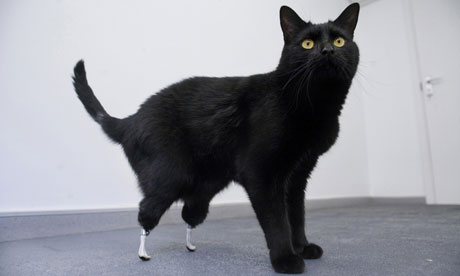
When I was a kid, I sometimes watched the television show, The Six Million Dollar Man. Even though the stories were silly, the technology was fascinating and the writers' predictions were inspiring for what those bionic limbs might be capable of doing. But bionic limbs are not the stuff of science fiction any longer; they are becoming reality, thanks to the work of Professor Gordon Blunn, Head of University College London's Centre for Bio-Medical Engineering, and his colleagues, including Dr Noel Fitzpatrick, a veterinary surgeon. Professor Blunn has been developing groundbreaking metal prosthetic implants that provide comfort and improved mobility for amputee humans and animals.
The key development in this new technology was learning how to fuse skin to metal so a biological interface would develop that prevents infections. This advance came from earlier research by Professor Blunn and a colleague, Dr Catherine Pendegrass, into how skin forms itself naturally around deer antlers. They found that in antlers, the bone structure under the skin is very different to that of the exposed bone.
"It was very porous, with lots of tiny holes, which the dermis [the inner layer of skin] webs its way into", explained Professor Blunn.
This observation led to their breakthrough development, known as Intraosseous Transcutaneous Amputation Prosthesis (ITAP), which uses a layer of porous and bioactive (hydroxyapatite-coated) surfaces that encourage adhesion by living tissues. This living "seal" prevents bacterial infections, thereby allowing surgeons to provide amputees with securely-attached limbs that carry weight in a natural way.
Currently, battery-powered sensors allow human amputees to consciously control the movement of downstream portions of the prosthetic limb, such as flexing the hand on a prosthetic arm. But even that is only a passing phase; already, the researchers have developed the ability to attach tendons to metal, allowing muscles to attach to and move the metal prosthetic "bone" just as they attached to and moved the original (replaced) bone.
Encouraged by these successes, Professor Blunn and his colleagues predict that within just five years, ITAP could provide the basis for fully functioning bionic limbs that are linked to the patient's nervous system.
In this fascinating video, Professor Blunn discusses his groundbreaking prosthetic implants that give amputee humans and animals improved mobility:
You can visit UCL's website and they also have a twitter account @uclnews.
Read more about Professor Blunn, and learn more about Noel Fitzpatrick's pioneering work with animals (especially dogs and cats) on this wonderful website.
.
email: grrlscientist@gmail.com
twitter: @GrrlScientist

